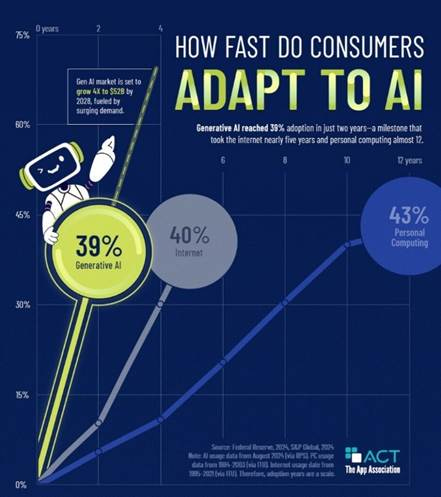Lessons from Enterprise AI Adoption
Enterprise AI use is surging. Some practices to make sure AI use is effective: Adapt AI to existing workflows, keep human in the loop, iterate quickly .

TL;DR
A16Z’s top Gen AI consumer apps report. Consumers lead but the enterprise follows fast.
Lessons learned from AI users and providers about enterprise AI adoption.
Takeaways for professional and individual AI users: Stay in the loop, iterate, use frameworks.
Usage Report from a16z
The VC firm Andreessen-Horowitz, also known as a16z, has just published their fifth “The Top 100 Gen AI Consumer Apps report, a report they update every six months.
There are no huge surprises here. a16z notes “The ecosystem is starting to stabilize, with 11 new names on the web list driven by traffic increases.” Some notable and interesting points:
ChatGPT continues to dominate. As the OG AI chatbot, OpenAI’s ChatGPT has rapidly grown since its 2022 launch to reaching 300 million weekly active users today. It’s not just number one; it’s market share is well ahead of any other AI application.
DeepSeek at number three beats out Grok, Perplexity, and Claude. The viral “DeepSeek” moment had a huge impact on the mindshare that DeepSeek has, but it also shows the strength of Chinese AI models and the size of the Chinese AI market.
Claude is an also-ran in this space, but they make up for it by being the dominant AI model under the hood for top 50 tools like Cursor, Lovable, Manus, and more.
Character AI platforms like Character.AI, JanitorAI, SpicyChat.AI, and Candy AI take up several slots on this list, indicating how big interacting and role-playing with AI characters has become.
Google shows up not just with Gemini, but with Google AI Studio (10), NotebookLM (13), and Google Labs (40).
There is one pure-play generalist AI agent on the list: Manus AI. But more specific AI agents show up indirectly on the list, such as Comet browser AI agent in Perplexity, or Cursor’s background agent for AI coding.
MetaAI at 46 looks like an also-ran, below fairly obscure sites and apps.
Consumers Lead but Enterprise Follows Fast
Generative AI has been the most quickly adopted new technology by consumers in history. The real early adopters and power users have been ‘prosumers,’ individuals using AI in their professional life. Whether in writing, software, marketing, business strategy, or science research, prosumer AI users have leveraged AI for personal productivity.
The enterprise hasn’t been slow to adopt AI but is not as fast-moving as consumers. There is a dichotomy where individual AI use, even in the workplace, has been more beneficial and productive than corporate mandates and implementations, which takes some time.

The enterprise is catching up though. Don’t believe the hype about that “95% failure rate” of generative AI use cases; this was about implementations that haven’t yet paid off, and it used a small sample and ignored key metrics to boot. In fact, most large-scale IT projects end up failing to meet budget and scope targets; new technology adoption is inherently high-risk. AI won’t be different.
There has been a surge in AI adoption across the board in 2025, both on consumer and on enterprise side. Enterprises are increasingly focused on deploying practical AI applications, from code generation to customer support to drug discovery. But how can enterprise AI users tilt the odds in their favor to be successful? Below we share lessons from recent enterprise AI adoption reports.
Block: Adapting AI to Processes, Building on Open Source
VentureBeat has reported struggles and successes with AI deployment and adoption in several recent articles. One theme is expressed in the headline, “Enterprise leaders say recipe for AI agents is matching them to existing processes.” In it, they highlight how Block, the payments company that runs Square, is dealing with AI adoption, in part by deploying their own AI agent framework, codenamed goose.
Adapt tools to existing processes is vital to success in the early stages of adoption, as users won’t adopt solutions that disrupt already optimized workflows. As Brad Axen, Block’s technical lead for AI and data platforms, told the reporter:
Process has been the biggest bottleneck. You can’t just give people a tool and tell them to make it work for them; agents need to reflect the processes that employees are already engaged with. Human users aren’t worried about the technical backbone, rather, the work they’re trying to accomplish.
Block took an interesting step earlier this year and released their AI agent platform codename goose to open source. The goose platform is built on standard protocols and is extensible with MCPs. It targets at “automating complex development tasks from start to finish” such as debugging code, deploying applications.
The Block development team built goose for their internal use on engineering tasks, and it’s now in use by 4,000 engineers in the company. Externally, the open source goose GitHub repo has a respectable 20k stars. Block’s internal experience makes it more likely their solution is useful to others.
Intuit: Iterating on AI Agents with GenOS
Intuit learned the hard way that AI can’t be an add-on feature bolted to pre-AI interfaces. They first tried to bolt on an AI chatbot interface, Intuit Assist, but it added little user value. From that failed experiment, they shifted and developed an AI solution that users really needed:
The pivot in the company's AI strategy began by observing customers as they did their work. Talach recalls his team's "big aha moment" when they noticed QuickBooks users manually transcribing invoices with a "split screen" – an email open on one side of their monitor, QuickBooks on the other.
Intuit made a pivot to embed AI agents directly into workflows, with a focus on finding ways to eliminate manual effort instead of introducing new chat interactions.
To support this, Intuit developed the GenOS platform to support development of generative AI features. Building on that, they developed a suite of integrated agentic AI features in QuickBooks that speed payments and significantly boost customer engagement:
Agentic AI workflows are now doing the hard work on behalf of customers by dynamically processing accounts receivable and accounts payable invoices with Intuit QuickBooks Online. This is complemented by personalized AI-driven insights and recommendations, and a seamless path to AI-powered human tax and bookkeeping experts whenever needed.
The AI agents support many time-saving tasks in QuickBooks:
The QuickBooks Payments Agent does things like proactively suggest adding late fees if a customer’s payment history shows they've been late in the past. …
The Customer Agent transforms QuickBooks into a lightweight CRM, scanning connected Gmail accounts for leads, while the Accounting Agent automates transaction categorization and flags anomalies.
The pillars of Intuit’s success with AI agents have been speed and iteration:
An AI builder culture of small, empowered cross-functional teams.
High-velocity iteration and customer-centric design - “a prototype is worth 10,000 words.”
The GenOS platform, which supports rapid development and itself evolved rapidly as business needs and demands grew.
Fast customer-focused iteration has been a formula for success in software technology before AI, but AI brings a new flavor to the process. The rapid rate of improvement in AI capabilities makes it more imperative to iterate faster and turn AI improvements into enhanced downstream features.
Netstock: Easing Customers into AI Agents
A counter-point to the “move fast and iterate” lesson from Intuit is how Netstock is easing small business in AI with practical tools. Netstock has been providing software for the supply chain and logistics industry for 16 years.
Netstock has developed AI agents tools such as the Generative AI Opportunity Engine, which provides real-time inventory recommendations; this has served over 1 million suggestions, saving businesses thousands of dollars with some recommendations. They have been enticing customers in this slow-to-adopt industry to cautiously adopt their human-supervised AI:
“Old family companies don’t trust blind change a lot,” chief innovation officer Jacob Moody [of Netstock customer Bargreen Ellingson] told TechCrunch. “I could not have gone into our warehouse and said, ‘Hey, this black box is going to start managing.’”
To help adoption, Moody pitched Netstock’s AI internally as a tool that warehouse managers could “either choose to use or not use” so the team was “eagerly, but cautiously dipping our toes” into AI:
“We’re not letting the AI engine make any inventory decisions that a human hasn’t looked at and screened and said, ‘Yes, I agree with that,’” he said. “If and when we ever get to a point where they agree with 90% of the stuff that it’s suggesting, maybe we’ll take the next step and say, ‘we’ll give you control now.’ But we’re not there yet.”
The lesson here is for those new to generative AI to crawl first, then walk, then run. Don’t force AI in a way that will throw off existing workflows or experience. As with the experience with Block, AI should work within existing flow in initial deployments, so respect the existing process and needs of users.
Conclusion
AI usage has been led by consumers but is now across the board, with almost all of us using AI at some level both at work and for personal use. In the enterprise, some trailblazers are adopting AI at the leading edge, while others move more cautiously and slowly.
Enterprise users have learned that AI enables more useful automation if existing workflows are followed not disrupted, and that prematurely automating with AI and removing human feedback short-circuits learning. It’s best to find discrete pain points for AI to solve and fix; that leads to small wins that can cascade to bigger workflow improvements later.
For your personal and professional use, some pointers in the same vein:
Crawl, walk, run: It’s more productive to give AI a subtask it’s over-powered for than over-task it and fail, so don’t task the AI beyond its capabilities. Get familiar with AI capabilities before you trust it. Vibe-coding in YOLO-mode is fun but can get you stuck in tech debt, so keep yourself in the loop of AI agent flows.
Iterate and keep improving: Keep using AI, experimenting with AI, and trying new things. Don’t assume that if you tried something with AI that didn’t work 6 months ago, it won’t work now. AI keeps improving; don’t settle and keep improving how you use AI.
Use AI Frameworks: The Block goose and Intuit GenOS AI agent platforms support AI agent development, helping those respective companies serve internal AI agents needs and customer use cases. If you want to develop your own AI agents, you’ll need an open framework like goose. There are many options.
If you want to use AI agents, interesting AI agent platforms and apps are now getting released. The ideal AI agent platform will be both robust and adaptable for personal customization. We haven’t seen one that meets that standard yet, but it won’t be long. We will report on any good AI agent releases and share our own assessments.


